Critical Evaluation of Journal Paper: Dementia & Doll Therapy Study
VerifiedAdded on 2022/08/17
|10
|2313
|22
Report
AI Summary
This report presents a critical evaluation of a journal paper by Moyle et al. (2019), which investigated the impact of lifelike baby dolls on reducing symptoms of anxiety, agitation, and aggression in dementia patients within long-term care facilities. The evaluation assesses the study's title and abstract, research design (including the mixed-method pilot study with a randomized controlled trial), sample and sampling techniques, data collection methods (quantitative and qualitative), data analysis processes, and results. The study found that doll intervention did not significantly reduce the target symptoms, though it increased pleasure. The report also discusses the study's relevance to nursing practice, emphasizing evidence-based practices and the importance of person-centered care. The evaluation highlights the strengths and limitations of the study, offering insights for healthcare professionals and researchers. The paper concludes with a discussion of the study's implications for nursing practice and future research directions.

Running head: CRITICAL EVALUATION OF JOURNAL PAPER
Critical Evaluation of Journal Paper
Name of the Student:
Name of the University:
Author note:
Critical Evaluation of Journal Paper
Name of the Student:
Name of the University:
Author note:
Paraphrase This Document
Need a fresh take? Get an instant paraphrase of this document with our AI Paraphraser
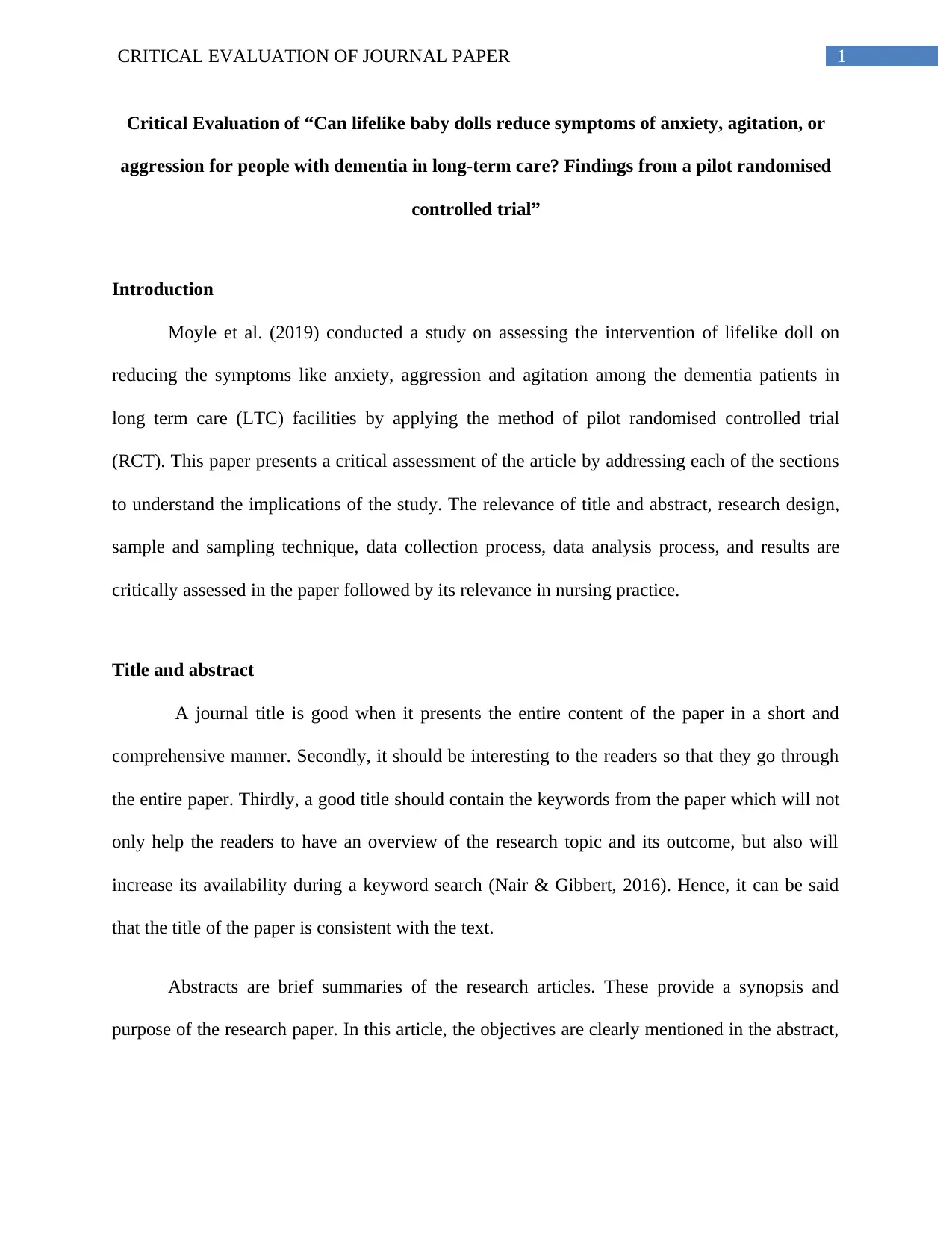
1CRITICAL EVALUATION OF JOURNAL PAPER
Critical Evaluation of “Can lifelike baby dolls reduce symptoms of anxiety, agitation, or
aggression for people with dementia in long-term care? Findings from a pilot randomised
controlled trial”
Introduction
Moyle et al. (2019) conducted a study on assessing the intervention of lifelike doll on
reducing the symptoms like anxiety, aggression and agitation among the dementia patients in
long term care (LTC) facilities by applying the method of pilot randomised controlled trial
(RCT). This paper presents a critical assessment of the article by addressing each of the sections
to understand the implications of the study. The relevance of title and abstract, research design,
sample and sampling technique, data collection process, data analysis process, and results are
critically assessed in the paper followed by its relevance in nursing practice.
Title and abstract
A journal title is good when it presents the entire content of the paper in a short and
comprehensive manner. Secondly, it should be interesting to the readers so that they go through
the entire paper. Thirdly, a good title should contain the keywords from the paper which will not
only help the readers to have an overview of the research topic and its outcome, but also will
increase its availability during a keyword search (Nair & Gibbert, 2016). Hence, it can be said
that the title of the paper is consistent with the text.
Abstracts are brief summaries of the research articles. These provide a synopsis and
purpose of the research paper. In this article, the objectives are clearly mentioned in the abstract,
Critical Evaluation of “Can lifelike baby dolls reduce symptoms of anxiety, agitation, or
aggression for people with dementia in long-term care? Findings from a pilot randomised
controlled trial”
Introduction
Moyle et al. (2019) conducted a study on assessing the intervention of lifelike doll on
reducing the symptoms like anxiety, aggression and agitation among the dementia patients in
long term care (LTC) facilities by applying the method of pilot randomised controlled trial
(RCT). This paper presents a critical assessment of the article by addressing each of the sections
to understand the implications of the study. The relevance of title and abstract, research design,
sample and sampling technique, data collection process, data analysis process, and results are
critically assessed in the paper followed by its relevance in nursing practice.
Title and abstract
A journal title is good when it presents the entire content of the paper in a short and
comprehensive manner. Secondly, it should be interesting to the readers so that they go through
the entire paper. Thirdly, a good title should contain the keywords from the paper which will not
only help the readers to have an overview of the research topic and its outcome, but also will
increase its availability during a keyword search (Nair & Gibbert, 2016). Hence, it can be said
that the title of the paper is consistent with the text.
Abstracts are brief summaries of the research articles. These provide a synopsis and
purpose of the research paper. In this article, the objectives are clearly mentioned in the abstract,
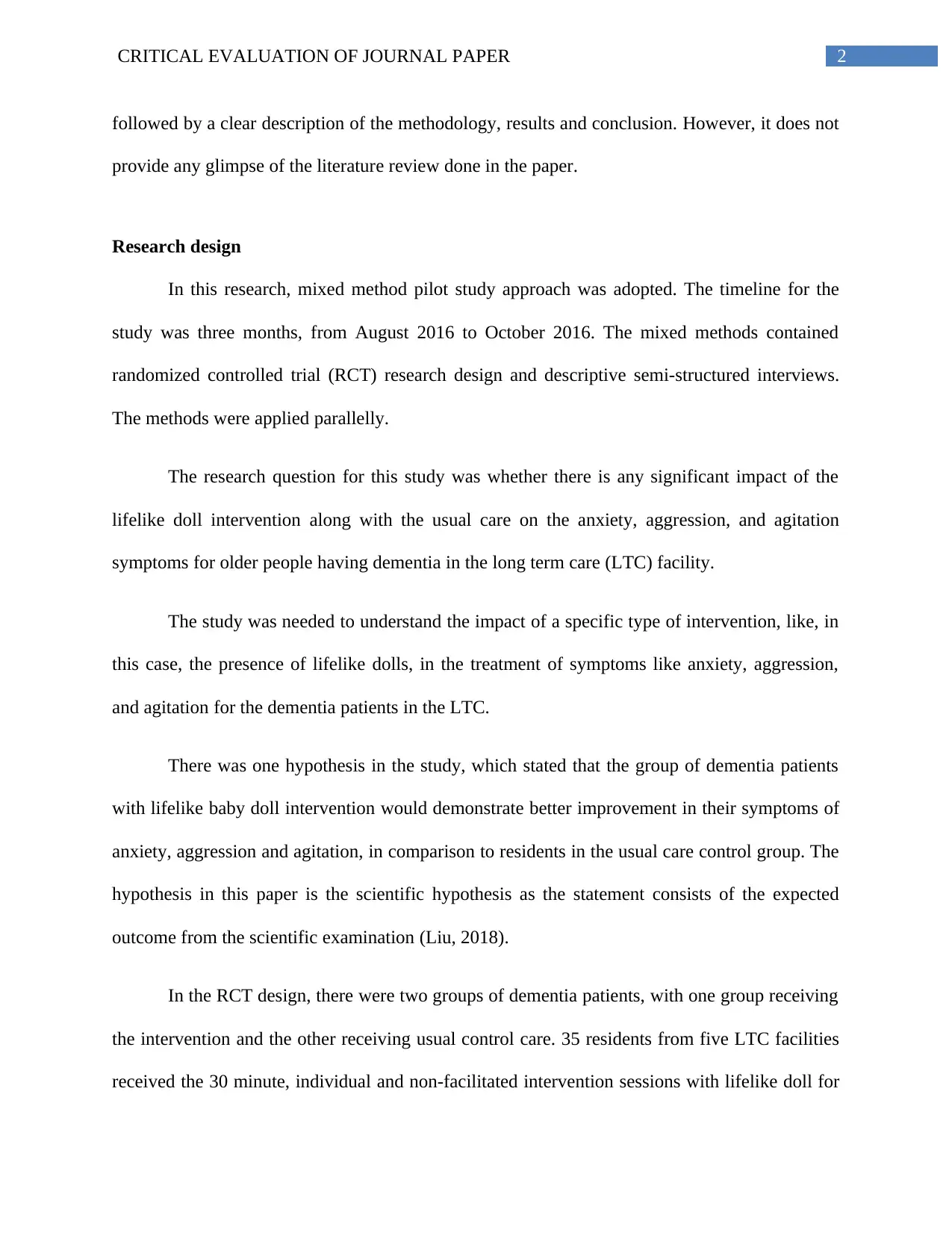
2CRITICAL EVALUATION OF JOURNAL PAPER
followed by a clear description of the methodology, results and conclusion. However, it does not
provide any glimpse of the literature review done in the paper.
Research design
In this research, mixed method pilot study approach was adopted. The timeline for the
study was three months, from August 2016 to October 2016. The mixed methods contained
randomized controlled trial (RCT) research design and descriptive semi-structured interviews.
The methods were applied parallelly.
The research question for this study was whether there is any significant impact of the
lifelike doll intervention along with the usual care on the anxiety, aggression, and agitation
symptoms for older people having dementia in the long term care (LTC) facility.
The study was needed to understand the impact of a specific type of intervention, like, in
this case, the presence of lifelike dolls, in the treatment of symptoms like anxiety, aggression,
and agitation for the dementia patients in the LTC.
There was one hypothesis in the study, which stated that the group of dementia patients
with lifelike baby doll intervention would demonstrate better improvement in their symptoms of
anxiety, aggression and agitation, in comparison to residents in the usual care control group. The
hypothesis in this paper is the scientific hypothesis as the statement consists of the expected
outcome from the scientific examination (Liu, 2018).
In the RCT design, there were two groups of dementia patients, with one group receiving
the intervention and the other receiving usual control care. 35 residents from five LTC facilities
received the 30 minute, individual and non-facilitated intervention sessions with lifelike doll for
followed by a clear description of the methodology, results and conclusion. However, it does not
provide any glimpse of the literature review done in the paper.
Research design
In this research, mixed method pilot study approach was adopted. The timeline for the
study was three months, from August 2016 to October 2016. The mixed methods contained
randomized controlled trial (RCT) research design and descriptive semi-structured interviews.
The methods were applied parallelly.
The research question for this study was whether there is any significant impact of the
lifelike doll intervention along with the usual care on the anxiety, aggression, and agitation
symptoms for older people having dementia in the long term care (LTC) facility.
The study was needed to understand the impact of a specific type of intervention, like, in
this case, the presence of lifelike dolls, in the treatment of symptoms like anxiety, aggression,
and agitation for the dementia patients in the LTC.
There was one hypothesis in the study, which stated that the group of dementia patients
with lifelike baby doll intervention would demonstrate better improvement in their symptoms of
anxiety, aggression and agitation, in comparison to residents in the usual care control group. The
hypothesis in this paper is the scientific hypothesis as the statement consists of the expected
outcome from the scientific examination (Liu, 2018).
In the RCT design, there were two groups of dementia patients, with one group receiving
the intervention and the other receiving usual control care. 35 residents from five LTC facilities
received the 30 minute, individual and non-facilitated intervention sessions with lifelike doll for
⊘ This is a preview!⊘
Do you want full access?
Subscribe today to unlock all pages.

Trusted by 1+ million students worldwide
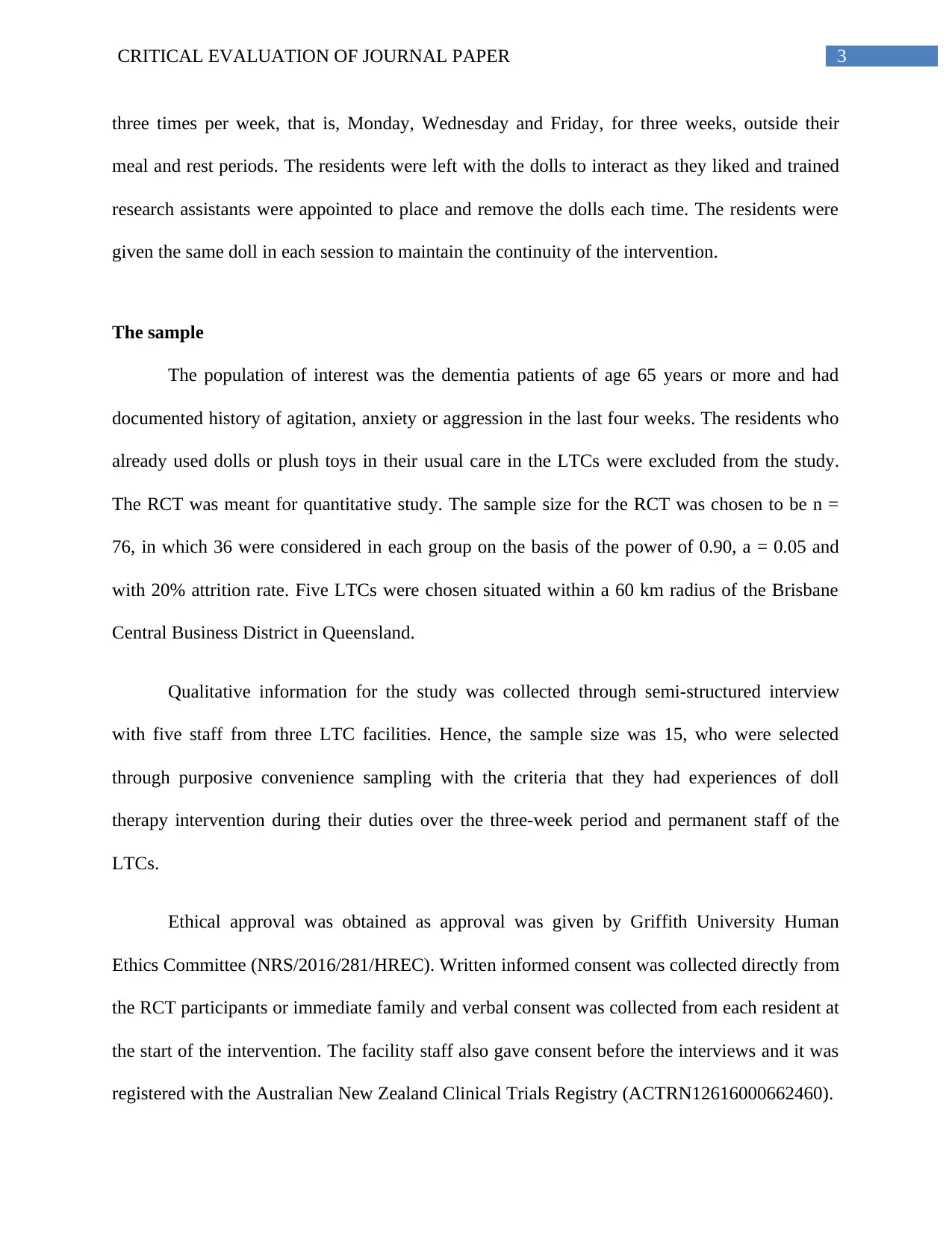
3CRITICAL EVALUATION OF JOURNAL PAPER
three times per week, that is, Monday, Wednesday and Friday, for three weeks, outside their
meal and rest periods. The residents were left with the dolls to interact as they liked and trained
research assistants were appointed to place and remove the dolls each time. The residents were
given the same doll in each session to maintain the continuity of the intervention.
The sample
The population of interest was the dementia patients of age 65 years or more and had
documented history of agitation, anxiety or aggression in the last four weeks. The residents who
already used dolls or plush toys in their usual care in the LTCs were excluded from the study.
The RCT was meant for quantitative study. The sample size for the RCT was chosen to be n =
76, in which 36 were considered in each group on the basis of the power of 0.90, a = 0.05 and
with 20% attrition rate. Five LTCs were chosen situated within a 60 km radius of the Brisbane
Central Business District in Queensland.
Qualitative information for the study was collected through semi-structured interview
with five staff from three LTC facilities. Hence, the sample size was 15, who were selected
through purposive convenience sampling with the criteria that they had experiences of doll
therapy intervention during their duties over the three-week period and permanent staff of the
LTCs.
Ethical approval was obtained as approval was given by Griffith University Human
Ethics Committee (NRS/2016/281/HREC). Written informed consent was collected directly from
the RCT participants or immediate family and verbal consent was collected from each resident at
the start of the intervention. The facility staff also gave consent before the interviews and it was
registered with the Australian New Zealand Clinical Trials Registry (ACTRN12616000662460).
three times per week, that is, Monday, Wednesday and Friday, for three weeks, outside their
meal and rest periods. The residents were left with the dolls to interact as they liked and trained
research assistants were appointed to place and remove the dolls each time. The residents were
given the same doll in each session to maintain the continuity of the intervention.
The sample
The population of interest was the dementia patients of age 65 years or more and had
documented history of agitation, anxiety or aggression in the last four weeks. The residents who
already used dolls or plush toys in their usual care in the LTCs were excluded from the study.
The RCT was meant for quantitative study. The sample size for the RCT was chosen to be n =
76, in which 36 were considered in each group on the basis of the power of 0.90, a = 0.05 and
with 20% attrition rate. Five LTCs were chosen situated within a 60 km radius of the Brisbane
Central Business District in Queensland.
Qualitative information for the study was collected through semi-structured interview
with five staff from three LTC facilities. Hence, the sample size was 15, who were selected
through purposive convenience sampling with the criteria that they had experiences of doll
therapy intervention during their duties over the three-week period and permanent staff of the
LTCs.
Ethical approval was obtained as approval was given by Griffith University Human
Ethics Committee (NRS/2016/281/HREC). Written informed consent was collected directly from
the RCT participants or immediate family and verbal consent was collected from each resident at
the start of the intervention. The facility staff also gave consent before the interviews and it was
registered with the Australian New Zealand Clinical Trials Registry (ACTRN12616000662460).
Paraphrase This Document
Need a fresh take? Get an instant paraphrase of this document with our AI Paraphraser
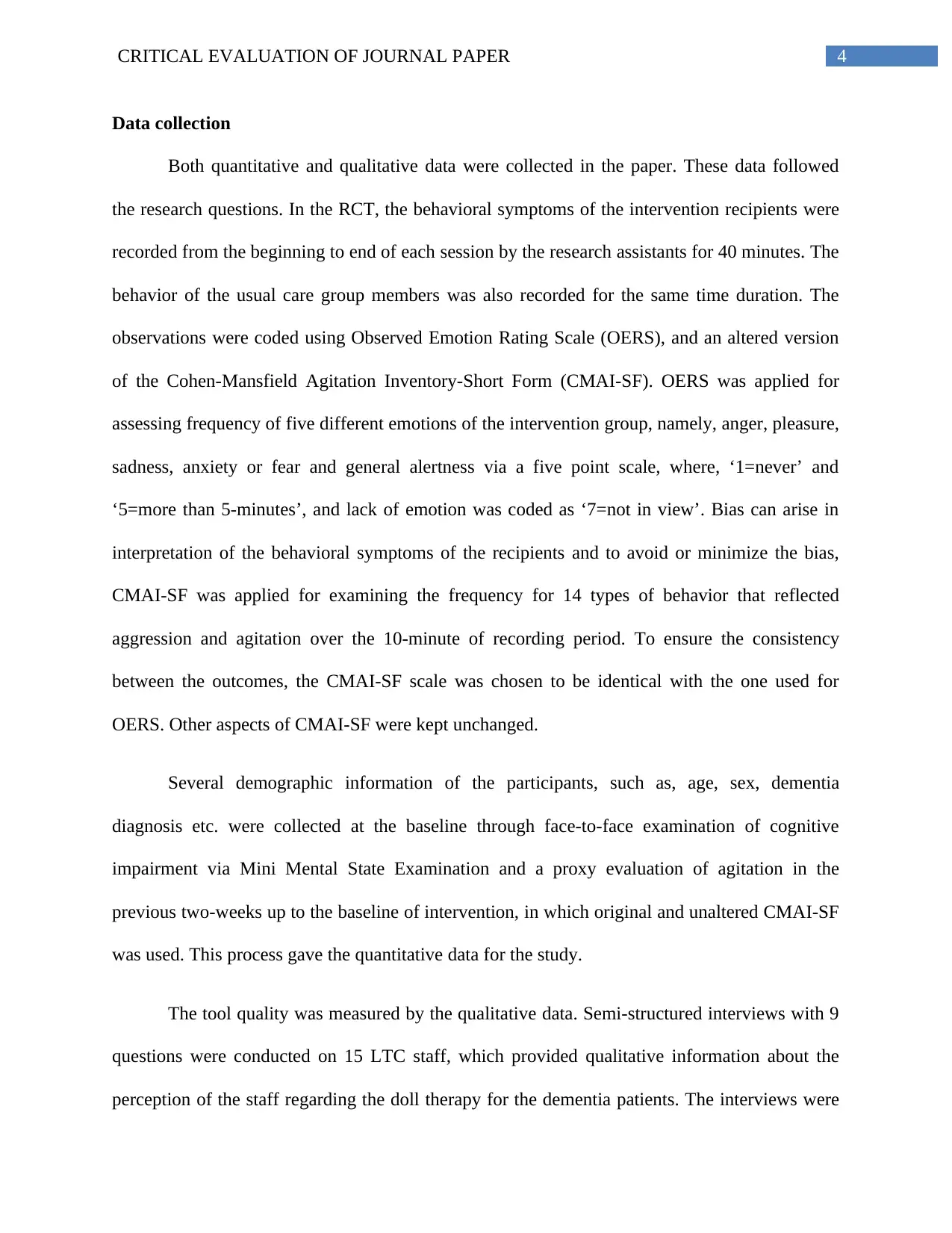
4CRITICAL EVALUATION OF JOURNAL PAPER
Data collection
Both quantitative and qualitative data were collected in the paper. These data followed
the research questions. In the RCT, the behavioral symptoms of the intervention recipients were
recorded from the beginning to end of each session by the research assistants for 40 minutes. The
behavior of the usual care group members was also recorded for the same time duration. The
observations were coded using Observed Emotion Rating Scale (OERS), and an altered version
of the Cohen-Mansfield Agitation Inventory-Short Form (CMAI-SF). OERS was applied for
assessing frequency of five different emotions of the intervention group, namely, anger, pleasure,
sadness, anxiety or fear and general alertness via a five point scale, where, ‘1=never’ and
‘5=more than 5-minutes’, and lack of emotion was coded as ‘7=not in view’. Bias can arise in
interpretation of the behavioral symptoms of the recipients and to avoid or minimize the bias,
CMAI-SF was applied for examining the frequency for 14 types of behavior that reflected
aggression and agitation over the 10-minute of recording period. To ensure the consistency
between the outcomes, the CMAI-SF scale was chosen to be identical with the one used for
OERS. Other aspects of CMAI-SF were kept unchanged.
Several demographic information of the participants, such as, age, sex, dementia
diagnosis etc. were collected at the baseline through face-to-face examination of cognitive
impairment via Mini Mental State Examination and a proxy evaluation of agitation in the
previous two-weeks up to the baseline of intervention, in which original and unaltered CMAI-SF
was used. This process gave the quantitative data for the study.
The tool quality was measured by the qualitative data. Semi-structured interviews with 9
questions were conducted on 15 LTC staff, which provided qualitative information about the
perception of the staff regarding the doll therapy for the dementia patients. The interviews were
Data collection
Both quantitative and qualitative data were collected in the paper. These data followed
the research questions. In the RCT, the behavioral symptoms of the intervention recipients were
recorded from the beginning to end of each session by the research assistants for 40 minutes. The
behavior of the usual care group members was also recorded for the same time duration. The
observations were coded using Observed Emotion Rating Scale (OERS), and an altered version
of the Cohen-Mansfield Agitation Inventory-Short Form (CMAI-SF). OERS was applied for
assessing frequency of five different emotions of the intervention group, namely, anger, pleasure,
sadness, anxiety or fear and general alertness via a five point scale, where, ‘1=never’ and
‘5=more than 5-minutes’, and lack of emotion was coded as ‘7=not in view’. Bias can arise in
interpretation of the behavioral symptoms of the recipients and to avoid or minimize the bias,
CMAI-SF was applied for examining the frequency for 14 types of behavior that reflected
aggression and agitation over the 10-minute of recording period. To ensure the consistency
between the outcomes, the CMAI-SF scale was chosen to be identical with the one used for
OERS. Other aspects of CMAI-SF were kept unchanged.
Several demographic information of the participants, such as, age, sex, dementia
diagnosis etc. were collected at the baseline through face-to-face examination of cognitive
impairment via Mini Mental State Examination and a proxy evaluation of agitation in the
previous two-weeks up to the baseline of intervention, in which original and unaltered CMAI-SF
was used. This process gave the quantitative data for the study.
The tool quality was measured by the qualitative data. Semi-structured interviews with 9
questions were conducted on 15 LTC staff, which provided qualitative information about the
perception of the staff regarding the doll therapy for the dementia patients. The interviews were

5CRITICAL EVALUATION OF JOURNAL PAPER
conducted by the project manager at the end of the intervention period over the telephone and
recorded, which was transcribed verbatim. During the interview, some basic demographic
information of the staff, like, gender, their position, length of their service time in the LTC and
tenure in the working for the aged care.
Data analysis
Descriptive statistics were calculated for the RCT recipients for demographic
information. The differences between the groups were assessed too. Intention-to-treat framework
was applied for inspecting and addressing the missing information through Last Observation
Carried Forward (LOCF) method. All the video-data interpretations were assessed through inter-
rater agreement calculations and accuracy was also checked. Two-way mixed MANOVA was
performed to analyze the intervention outcomes from the baseline to the week 3 and also at week
1 for getting the short term effects. p<0.05 was considered as the statistical significance level and
significant differences were investigated and evaluated with interpretation values Cohen’s d
effect sizes 0.2 = small, 0.5 = medium, and 0.8 = large. The video observations were analyzed
using IBM SPSS version 25. 20% of the data was extracted and entered at each of the assessment
step for checking the raw files and paperwork.
Results
The result of the RCT showed that the doll intervention did not have significant effect on
reducing the symptoms like anxiety, aggression or agitation in comparison to the recipients of
usual care at the 3rd week in primary outcome and at the first week as the secondary outcome. At
the same time, it was observed that there was a larger increase in the demonstration of pleasure at
3rd week for the RCT group in comparison to the baseline for usual care group (F(1,31) = 4.400,
conducted by the project manager at the end of the intervention period over the telephone and
recorded, which was transcribed verbatim. During the interview, some basic demographic
information of the staff, like, gender, their position, length of their service time in the LTC and
tenure in the working for the aged care.
Data analysis
Descriptive statistics were calculated for the RCT recipients for demographic
information. The differences between the groups were assessed too. Intention-to-treat framework
was applied for inspecting and addressing the missing information through Last Observation
Carried Forward (LOCF) method. All the video-data interpretations were assessed through inter-
rater agreement calculations and accuracy was also checked. Two-way mixed MANOVA was
performed to analyze the intervention outcomes from the baseline to the week 3 and also at week
1 for getting the short term effects. p<0.05 was considered as the statistical significance level and
significant differences were investigated and evaluated with interpretation values Cohen’s d
effect sizes 0.2 = small, 0.5 = medium, and 0.8 = large. The video observations were analyzed
using IBM SPSS version 25. 20% of the data was extracted and entered at each of the assessment
step for checking the raw files and paperwork.
Results
The result of the RCT showed that the doll intervention did not have significant effect on
reducing the symptoms like anxiety, aggression or agitation in comparison to the recipients of
usual care at the 3rd week in primary outcome and at the first week as the secondary outcome. At
the same time, it was observed that there was a larger increase in the demonstration of pleasure at
3rd week for the RCT group in comparison to the baseline for usual care group (F(1,31) = 4.400,
⊘ This is a preview!⊘
Do you want full access?
Subscribe today to unlock all pages.

Trusted by 1+ million students worldwide
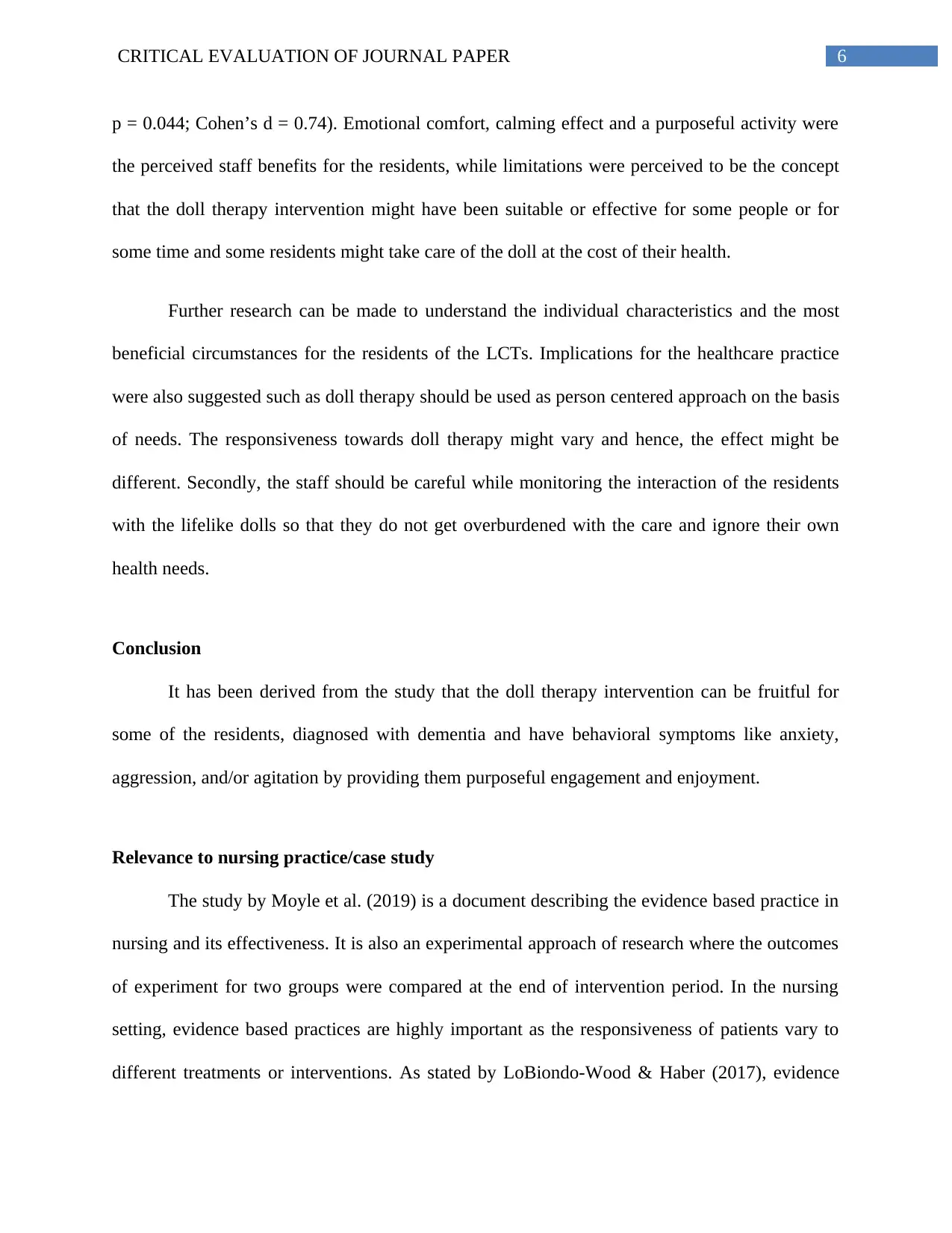
6CRITICAL EVALUATION OF JOURNAL PAPER
p = 0.044; Cohen’s d = 0.74). Emotional comfort, calming effect and a purposeful activity were
the perceived staff benefits for the residents, while limitations were perceived to be the concept
that the doll therapy intervention might have been suitable or effective for some people or for
some time and some residents might take care of the doll at the cost of their health.
Further research can be made to understand the individual characteristics and the most
beneficial circumstances for the residents of the LCTs. Implications for the healthcare practice
were also suggested such as doll therapy should be used as person centered approach on the basis
of needs. The responsiveness towards doll therapy might vary and hence, the effect might be
different. Secondly, the staff should be careful while monitoring the interaction of the residents
with the lifelike dolls so that they do not get overburdened with the care and ignore their own
health needs.
Conclusion
It has been derived from the study that the doll therapy intervention can be fruitful for
some of the residents, diagnosed with dementia and have behavioral symptoms like anxiety,
aggression, and/or agitation by providing them purposeful engagement and enjoyment.
Relevance to nursing practice/case study
The study by Moyle et al. (2019) is a document describing the evidence based practice in
nursing and its effectiveness. It is also an experimental approach of research where the outcomes
of experiment for two groups were compared at the end of intervention period. In the nursing
setting, evidence based practices are highly important as the responsiveness of patients vary to
different treatments or interventions. As stated by LoBiondo-Wood & Haber (2017), evidence
p = 0.044; Cohen’s d = 0.74). Emotional comfort, calming effect and a purposeful activity were
the perceived staff benefits for the residents, while limitations were perceived to be the concept
that the doll therapy intervention might have been suitable or effective for some people or for
some time and some residents might take care of the doll at the cost of their health.
Further research can be made to understand the individual characteristics and the most
beneficial circumstances for the residents of the LCTs. Implications for the healthcare practice
were also suggested such as doll therapy should be used as person centered approach on the basis
of needs. The responsiveness towards doll therapy might vary and hence, the effect might be
different. Secondly, the staff should be careful while monitoring the interaction of the residents
with the lifelike dolls so that they do not get overburdened with the care and ignore their own
health needs.
Conclusion
It has been derived from the study that the doll therapy intervention can be fruitful for
some of the residents, diagnosed with dementia and have behavioral symptoms like anxiety,
aggression, and/or agitation by providing them purposeful engagement and enjoyment.
Relevance to nursing practice/case study
The study by Moyle et al. (2019) is a document describing the evidence based practice in
nursing and its effectiveness. It is also an experimental approach of research where the outcomes
of experiment for two groups were compared at the end of intervention period. In the nursing
setting, evidence based practices are highly important as the responsiveness of patients vary to
different treatments or interventions. As stated by LoBiondo-Wood & Haber (2017), evidence
Paraphrase This Document
Need a fresh take? Get an instant paraphrase of this document with our AI Paraphraser
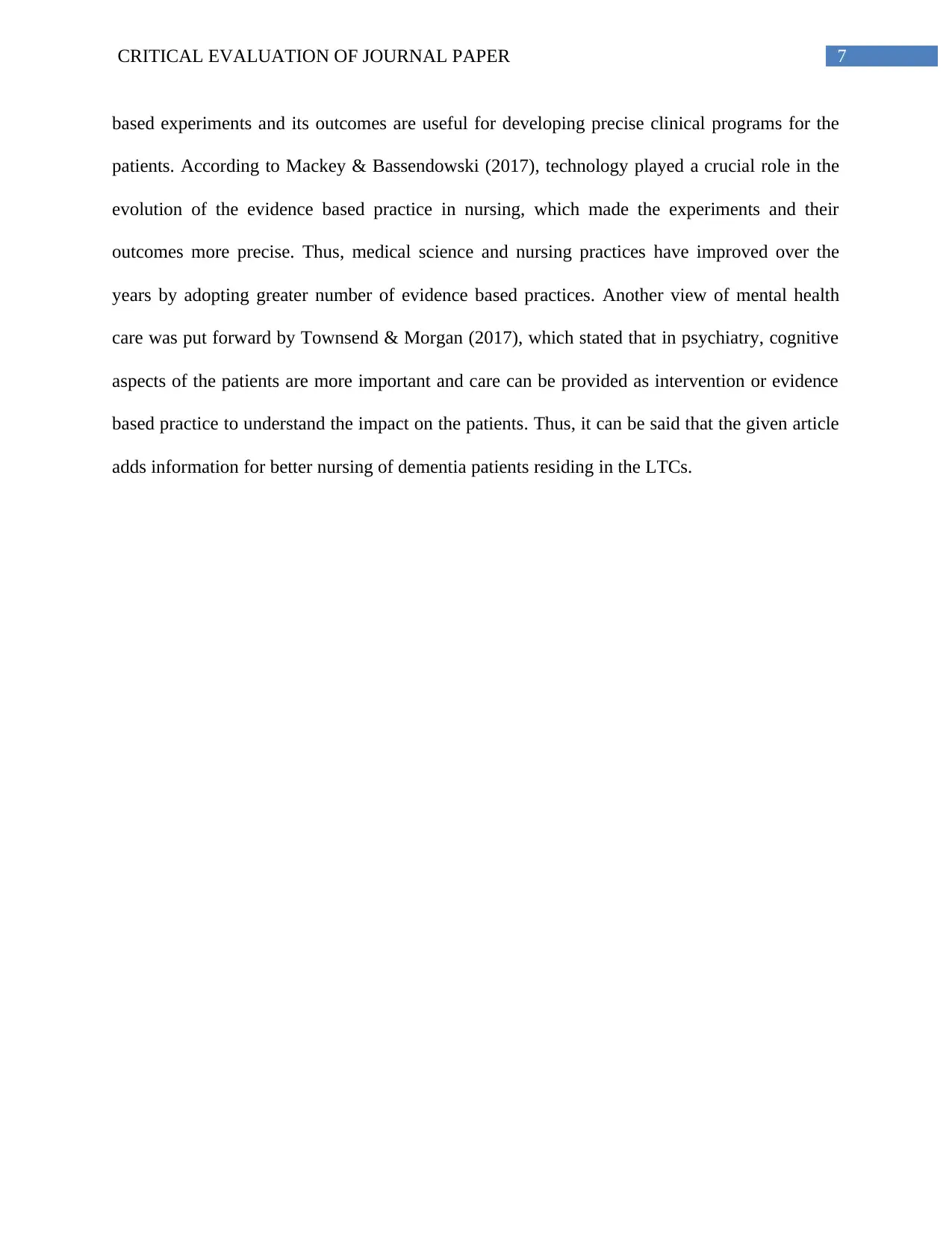
7CRITICAL EVALUATION OF JOURNAL PAPER
based experiments and its outcomes are useful for developing precise clinical programs for the
patients. According to Mackey & Bassendowski (2017), technology played a crucial role in the
evolution of the evidence based practice in nursing, which made the experiments and their
outcomes more precise. Thus, medical science and nursing practices have improved over the
years by adopting greater number of evidence based practices. Another view of mental health
care was put forward by Townsend & Morgan (2017), which stated that in psychiatry, cognitive
aspects of the patients are more important and care can be provided as intervention or evidence
based practice to understand the impact on the patients. Thus, it can be said that the given article
adds information for better nursing of dementia patients residing in the LTCs.
based experiments and its outcomes are useful for developing precise clinical programs for the
patients. According to Mackey & Bassendowski (2017), technology played a crucial role in the
evolution of the evidence based practice in nursing, which made the experiments and their
outcomes more precise. Thus, medical science and nursing practices have improved over the
years by adopting greater number of evidence based practices. Another view of mental health
care was put forward by Townsend & Morgan (2017), which stated that in psychiatry, cognitive
aspects of the patients are more important and care can be provided as intervention or evidence
based practice to understand the impact on the patients. Thus, it can be said that the given article
adds information for better nursing of dementia patients residing in the LTCs.
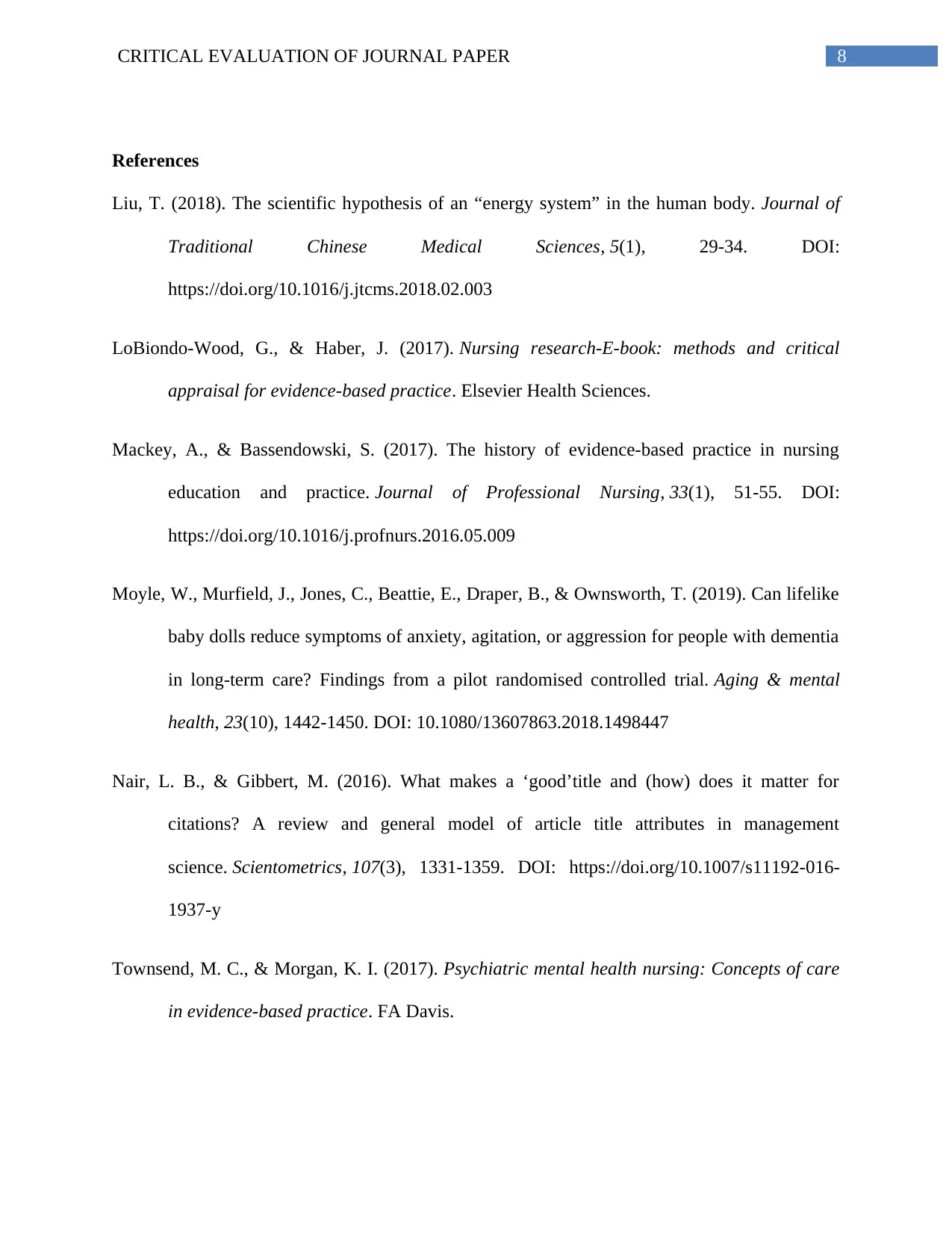
8CRITICAL EVALUATION OF JOURNAL PAPER
References
Liu, T. (2018). The scientific hypothesis of an “energy system” in the human body. Journal of
Traditional Chinese Medical Sciences, 5(1), 29-34. DOI:
https://doi.org/10.1016/j.jtcms.2018.02.003
LoBiondo-Wood, G., & Haber, J. (2017). Nursing research-E-book: methods and critical
appraisal for evidence-based practice. Elsevier Health Sciences.
Mackey, A., & Bassendowski, S. (2017). The history of evidence-based practice in nursing
education and practice. Journal of Professional Nursing, 33(1), 51-55. DOI:
https://doi.org/10.1016/j.profnurs.2016.05.009
Moyle, W., Murfield, J., Jones, C., Beattie, E., Draper, B., & Ownsworth, T. (2019). Can lifelike
baby dolls reduce symptoms of anxiety, agitation, or aggression for people with dementia
in long-term care? Findings from a pilot randomised controlled trial. Aging & mental
health, 23(10), 1442-1450. DOI: 10.1080/13607863.2018.1498447
Nair, L. B., & Gibbert, M. (2016). What makes a ‘good’title and (how) does it matter for
citations? A review and general model of article title attributes in management
science. Scientometrics, 107(3), 1331-1359. DOI: https://doi.org/10.1007/s11192-016-
1937-y
Townsend, M. C., & Morgan, K. I. (2017). Psychiatric mental health nursing: Concepts of care
in evidence-based practice. FA Davis.
References
Liu, T. (2018). The scientific hypothesis of an “energy system” in the human body. Journal of
Traditional Chinese Medical Sciences, 5(1), 29-34. DOI:
https://doi.org/10.1016/j.jtcms.2018.02.003
LoBiondo-Wood, G., & Haber, J. (2017). Nursing research-E-book: methods and critical
appraisal for evidence-based practice. Elsevier Health Sciences.
Mackey, A., & Bassendowski, S. (2017). The history of evidence-based practice in nursing
education and practice. Journal of Professional Nursing, 33(1), 51-55. DOI:
https://doi.org/10.1016/j.profnurs.2016.05.009
Moyle, W., Murfield, J., Jones, C., Beattie, E., Draper, B., & Ownsworth, T. (2019). Can lifelike
baby dolls reduce symptoms of anxiety, agitation, or aggression for people with dementia
in long-term care? Findings from a pilot randomised controlled trial. Aging & mental
health, 23(10), 1442-1450. DOI: 10.1080/13607863.2018.1498447
Nair, L. B., & Gibbert, M. (2016). What makes a ‘good’title and (how) does it matter for
citations? A review and general model of article title attributes in management
science. Scientometrics, 107(3), 1331-1359. DOI: https://doi.org/10.1007/s11192-016-
1937-y
Townsend, M. C., & Morgan, K. I. (2017). Psychiatric mental health nursing: Concepts of care
in evidence-based practice. FA Davis.
⊘ This is a preview!⊘
Do you want full access?
Subscribe today to unlock all pages.

Trusted by 1+ million students worldwide

9CRITICAL EVALUATION OF JOURNAL PAPER
1 out of 10